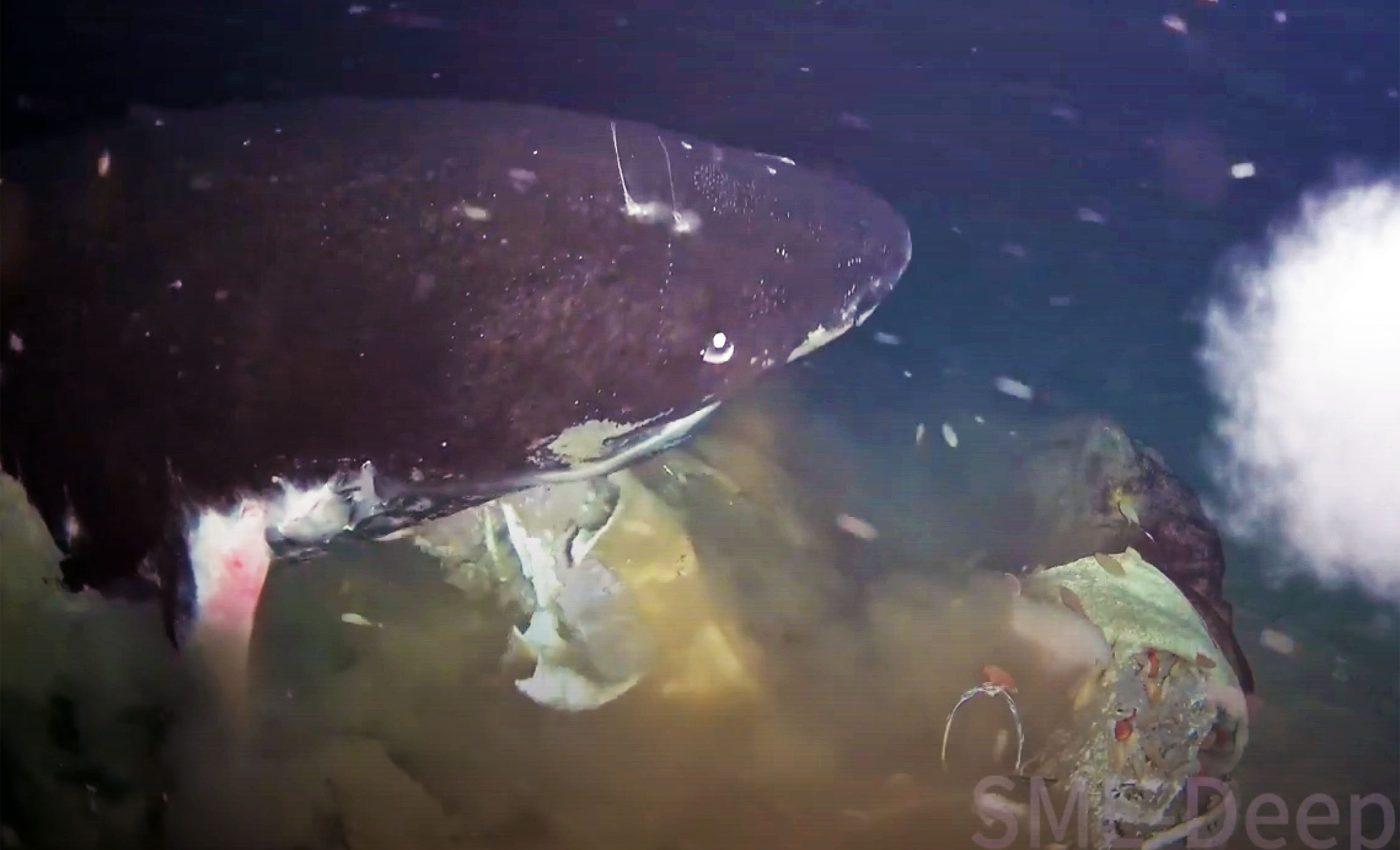
Rare video shows elusive deep-sea predators feeding thousands of miles from home
When researchers lowered a cow carcass 5,345 feet (1,629 meters) beneath the waves off Hainan Island, they were studying natural whale fall processes in the deep sea. Instead, the bait attracted uninvited guests never before filmed in these waters: Pacific sleeper sharks (Somniosus pacificus).
The video, captured on the continental slope of the northern South China Sea, marks the species’ southernmost sighting in the Pacific Basin.
It also reveals a suite of behaviors – from polite feeding queues to protective eye retractions – that deepen our understanding of how large predators survive in the deep ocean.
Sharks spotted far from home
Until now, Pacific sleeper sharks were considered residents of the North Pacific, with records stretching from Japan and the Bering Sea to Alaska and as far south as Baja California. Their sudden appearance in tropical latitudes stunned marine biologists.
The deployment, designed to mimic a natural whale fall, quickly drew multiple sharks that took turns tearing at the carcass.
Because sleeper sharks routinely dive below 3,280 feet (1,000 meters), direct observations have been scarce. Remote baited cameras provided the first clear window into their deep-sea routines.
Size shapes shark feeding style
Back on shore, the research team reviewed hours of footage and divided the sharks into two categories: individuals longer than 8.85 feet (2.7 meters) and those shorter.
The threshold was chosen purely as a reference point, not as a marker of maturity.
Size proved to be a major factor in feeding style. The bigger sharks charged the carcass head-on, ripping chunks of flesh with sweeping bites. Smaller sharks kept their distance, circling watchfully before making tentative nips.
The contrast suggests a competitive hierarchy in which bulk confers priority access to limited resources.
Sharks take polite turns
Perhaps the most unexpected behavior was a kind of underwater etiquette. As each shark finished feeding, it glided away, making room for the next arrival.
On the video camera footage, the handover looked almost orderly, with newcomers approaching steadily from behind while current feeders yielded position.
“This behavior suggests that feeding priority is determined by individual competitive intensity, even in deep-water environments,” said study author Han Tian, a marine biologist at Sun Yat-sen University.
“This reflects a survival strategy suitable for non-solitary foraging among Pacific sleeper sharks.”
Comparable line-ups have been reported when sharks scavenge floating whale carcasses near the surface, where space is equally contested.
The deep-sea footage indicates that such social rules persist even in the aphotic zone, where encounters are rare and every calorie counts.
Defensive eye roll
Pacific sleeper sharks lack the nictitating membrane – a transparent eyelid – found in many shark species. Yet the video shows them repeatedly retracting their eyes while feeding.
Scientists interpret this as a built-in safeguard against sudden jabs from protruding bones or the teeth of rival sharks.
The involuntary eye roll could compensate for the missing membrane, protecting vision during frenzied meals.
Clues to an expanded range
Finding Pacific sleeper sharks 1,800 miles (3,000 kilometers) south of their documented range forces scientists to rethink what governs their distribution.
Do shifting ocean temperatures invite them farther into the tropics? Or does the South China Sea offer prey reservoirs that make the journey worthwhile?
All individuals filmed were female – a pattern echoed by other rarely seen giants such as the megamouth shark, which also shows a female bias here.
The sex skew hints that the region might double as a nursery or feeding ground for pregnant sharks needing high-energy meals.
Energy in the abyss
Large predators cannot thrive without a steady food supply. Sleeper sharks typically scavenge or ambush seals and squids in colder waters.
In the subtropical South China Sea, their presence implies robust nutrient pathways moving organic matter from surface ecosystems to abyssal depths.

“The highly aggressive behavior of sharks observed in the South China Sea suggests that this region still harbors abundant food sources in the deep sea,” Tan said.
“But what exactly are they? This question is intriguing for both animal distribution and behavioral research.”
Tracking sharks in the deep
The team plans to deploy additional baited cameras and environmental DNA samplers across the basin to gauge how many Pacific sleeper sharks prowl these depths and whether they stay year-round.
Comparative studies from other oceans could reveal whether deep-water queuing is widespread among large scavengers or unique to this lineage.
Biologists also hope to determine if climatic changes or altered current patterns are drawing cold-adapted predators southward.
Answers will feed into global models of deep-sea energy flow and illuminate how carbon moves from surface waters to the seafloor, a key piece of the climate puzzle.
For now, the footage shatters old assumptions. Pacific sleeper sharks are not confined to polar and subpolar seas.
They form loose social hierarchies, even in perpetual darkness, and they may rely on uncharted nutrient highways that link surface productivity with the deep ocean.
—–
Click here to watch the full video footage…
The study is published in the journal Ocean-Land-Atmosphere Research.
—–
Like what you read? Subscribe to our newsletter for engaging articles, exclusive content, and the latest updates.
Check us out on EarthSnap, a free app brought to you by Eric Ralls and Earth.com.
—–













